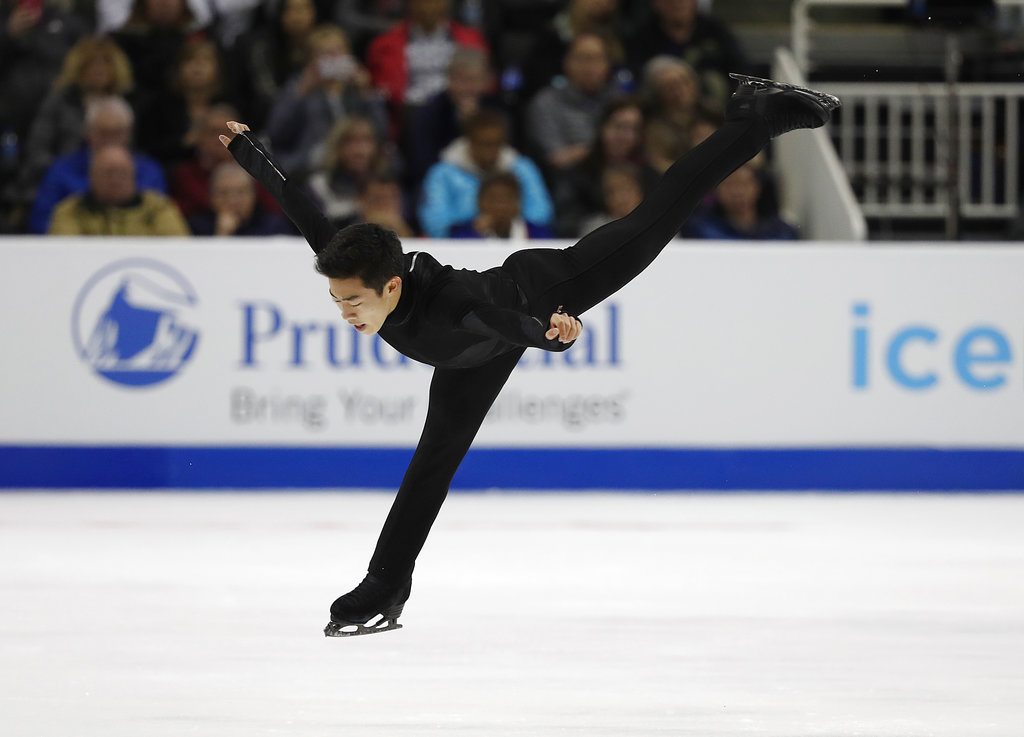Figure skating debate rages between artistry, amplitude

FILE – In this Saturday, Jan. 6, 2018, file photo, Nathan Chen performs in the men’s free skate program at the U.S. Figure Skating Championships in San Jose, Calif. Chen is planning an audacious five quads in his free skate at next month’s Pyeongchang Olympics, and it could take at least three or four to have any shot at landing on the podium (AP Photo/Tony Avelar, File)
Patrick Chan remembers just about everything from his Olympic debut eight years ago in Vancouver, including the controversy that erupted when Evan Lysacek won the gold medal.
Evgeni Plushenko of Russia landed quadruple jumps, the toughest in figure skating, in combination with a triple toe loop in both his short and long programs. But despite leading after the short program, Plushenko was beaten out by his American rival despite Lysacek never attempting a single quad.
Article continues after this advertisementLysacek was rewarded for artistry over amplitude.
Fast-forward to next month’s Pyeongchang Olympics, and Chan is amazed at the transformation that has taken place in the sport. Nathan Chen of the United States is planning an audacious five quads in his free skate, and it could take at least three or four to have any shot at landing on the podium.
It begs the question: Is artistry dead in this brave new era?
Article continues after this advertisement“I’ve kind of come to the point where I don’t really want to put any energy toward what others are doing,” the Canadian champ said with sort of an audible shrug. “I’ve been through it all. I’ve kind of lived the bridge between these two generations. I hope I can be one of those skaters that’s a little bit like Switzerland, right in the middle. A technically sound skater and an artistically sound skater.
“I’m the only skater that can offer that. I may be the last,” said Chan, the reigning Olympic silver medalist. “On the other hand, it’s very exciting to see some of these other skaters defy physics and expectations and break records.”
The controversy in Vancouver in many ways led to the current controversy between artistry and amplitude. As a result of Lysacek’s gold, the International Skating Union revised the scoring for quads, pushing the value of it over 10 points and essentially making it a program requirement.
It’s been a boon for someone like Chen, whose ability to jump higher and spin faster than his rivals gives him a major advantage. But it’s been a major obstacle for veterans such as Chan and American skater Adam Rippon, who have quads in their arsenal but lean on artistry and elegance.
“I spoke to Nathan Chen last year and asked what got him motivated to go after six quads, five quads, and he said it all started at the junior level, looking up at the seniors doing three quads,” Chan said. “The only way to compete with us was to up the game technically.”
Even those who’ve embraced figure skating’s high-flying age argue there is still room for artistry in programs, pointing straight to the ISU’s current scoring system for evidence.
Yes, the points accumulated for jumps are substantial. But there remains a component score in which judges grade skating skills, transitions, performance, composition and interpretation.
Those are the scores that give skaters such as Rippon a chance to compete at the highest level.
The critics of figure skating’s current age, including two-time Olympic champion Dick Button, are just as quick to bemoan the way jumping ability has superseded everything else.
“I don’t think the rules are 50-50, technical ability and creative ability,” said Button, also a longtime TV analyst. “I don’t even enjoy watching skating today, because it’s all about quadruple jumps, and the winner of the Olympic Games in men’s figure skating will be the skater that performs the best and most quadruple jumps. Period. End of subject.”
It’s not just quads on the men’s side, either. The amplitude/artistry debate rages on the women’s side, where triple-triple combinations have become essential for landing on the podium.
“I think the cream rises to the top,” 1998 Olympic champion Tara Lipinski said. “Not every skater can do triple-triples in the second half of a program, and put out an artistic, emotional performance. But there are skaters who do, and those are the ones that are winning.”
Six-time European champion Javier Fernandez of Spain believes there is already a pushback against the quad craziness. But the changes certainly won’t take hold until well after Pyeongchang.
“I think at some point the ISU will maybe put a limit on the number of quads you can do in a competition or in a free program,” Fernandez said. “Let’s say three persons can do four quads, or three quads, whatever, and all of them land the quads they have planned. Then the skating’s going to tell who is the best skater, who’s going to win.
“Skating is about who is the most complete, not who is the best jumper, right?” Fernandez added. “So that’s the point I think everybody is having in mind right now. “